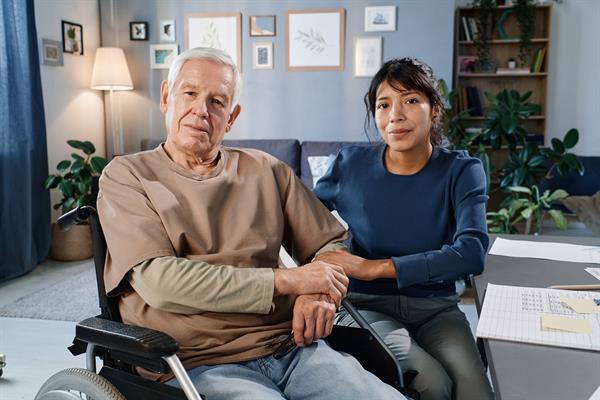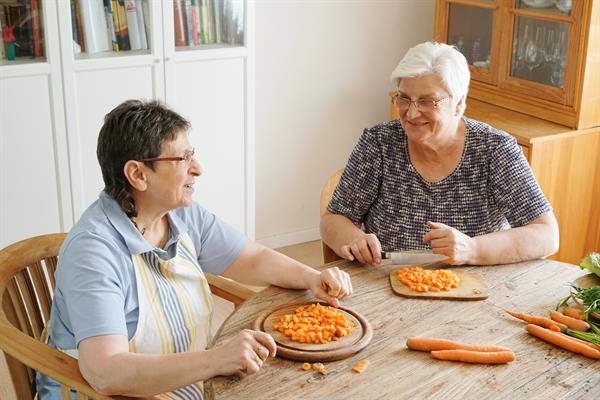When we notice that an elderly loved one could use a little help due to illness, mobility issues, or the natural course of aging, it might be time to look at living arrangements that best suit their changing needs.
For families reaching senior care options for the first time, the process can be daunting. One of the keys to making an informed decision with peace of mind is knowing which care arrangements offer the correct level of care for the older adult.
Two terms that often come up when researching senior care are "independent living" and "assisted living". As the names suggest, the main differences between these two categories are:
Independent living communities are for older adults who don't need much support with day-to-day tasks and mostly depend on the senior living community to provide a supportive environment including some meals and to help fulfill their social needs. Although help with everyday tasks is often available, it's often not required by the resident.
Assisted living communities provide support for those needing assistance with activities of daily living (ADLs) but can still live relatively independently and take advantage of many social aspects of the community. Assisted living may also include memory care units specially built for people with Alzheimer's disease or dementia.
However, there are still some differences between the two levels of care that you should be aware of, such as:
- Medical Care and daily support: Independent living facilities typically don't offer on-site nursing or other medical type support to their residents. In most cases, older adults living independently are able to safely manage the community, and safely manage their day-to-day affairs while benefiting from a supportive environment provided by the community.
Most assisted living facilities provide residents the same benefits as independent living, and add help with ADLs, such as bathing, grooming, dressing, meal prep, and more. Most assisted living communities provide LPN nursing during the day and some assisted living communities also have a registered nurse on staff during the day or 24 hours a day.
- Living Spaces: The residential units within independent living communities can range from apartments to patio-style homes.. For the most part, older adults have private dwellings with access to common areas such as a pool, gym, or common socializing areas within each community like libraries, fireplace areas, and games rooms where residents can socialize with other community members. Independently living in a senior community isn't much different from having an apartment or small home anywhere else, but maintenance-free and includes meals, transportation, and social structure..
Assisted living is usually apartment-style only, and the units may or may not have a kitchen. Otherwise, assisted living can look and feel just like independent living in many respects. Memory care units may include enhanced sightlines so the resident can find their way around with more confidence. They also feature increased safety measures such as locking doors and extra surveillance equipment. Memory care units will not have kitchens due to safety concerns.
- Amenities and Programs: Independent and assisted living communities offer the same amenities, such as housekeeping, transportation services, social activities, libraries, cafes, and games rooms for all abilities. Typical activities include game nights, field trips, music nights, support and discussion groups, holiday celebrations, exercise classes, and continuing education courses. Memory care activities are generally tailored toward physical and cognitive stimulation and are delivered in smaller groups.
Both types of communities also provide transportation services for shuttling residents to and from doctor's appointments, grocery stores, and to run other errands.
Meals are often included as part of the monthly fee in independent and assisted living. Independent living often includes one meal per day while assisted living includes 3 meals. However, independent living may offer a wider variety of options, from fine dining to casual take-out. Meals in assisted living are typically taken in the common dining area. However, residents can take their food back to their unit if they want to have a quiet meal while watching a favorite movie or television program.
- How costs are paid: Independent living residents may pay an entrance fee upon moving in (much of which is refundable when you move out) and an additional monthly fee covering maintenance, housekeeping, security, some meals, amenities, and programs. Other independent living communities only require a small one-time community fee which is often less than $5,000.
Because independent living communities don't offer medical services, Medicare, Medicaid, long-term care insurance, and other financial aid programs won't cover the costs. Instead, residents have to pay privately, using Social Security benefits, pension income, retirement savings, life settlements, life insurance annuities, and other funding sources.
Older adults pay for assisted living using a rental plus care model. The monthly fee covers maintenance, housekeeping, security, three meals per day, nursing observation, programming, and 24/7 staffing. Daily personal care such as assistance with bathing, grooming, and medication management is included in an additional level of care charge or bundled together into an all-inclusive price that includes rent and care charges. .
You generally pay out-of-pocket for assisted living from the sources listed above. However, since assisted living offers required medical and physical services, more options are available to cover the costs than in independent living. Medicaid provides some financial assistance to low-income seniors in Ohio and only select communities accept Medicaid. Residents can also access funds from specific long-term care insurance policies and veteran's benefits to cover assisted living costs. Some communities also offer subsidy programs for older people who qualify. Medicare does not cover assisted living expenses.
- Family involvement: One question my clients ask is how active they can be in making decisions for their older loved ones within the community. Generally speaking, families are encouraged to immerse themselves in the independent living community, including participating in the amenities and sharing meals with their relatives, but the resident does most of the decision-making.
Families take more of an active role in their loved one's care in assisted living and memory care. Designated family members are apprised of the older adult's ongoing condition and are directly involved with progressive care planning.
Help with finding senior living communities in the Greater Cincinnati Area
Navigating the world of senior living communities is a challenge for many families, especially if they're searching for the right living arrangement on their own. The process can be confusing, there are many pitfalls to watch out for, and so many details to consider that making an informed choice can be overwhelming.
Assisted Living Locators of Greater Cincinnati can help you find the most appropriate senior living community for your loved one. We take the time to get to know your loved one's needs, answer all of your questions, and present a list of the best-matched independent senior living, assisted living, Alzheimer's/memory care, and continuing care retirement communities in your area. We'll even accompany you on your community tours and help ensure all your questions are answered and your concerns addressed.
Contact Assisted Living Locators of Greater Cincinnati to start finding the best senior living services for your loved one today.




